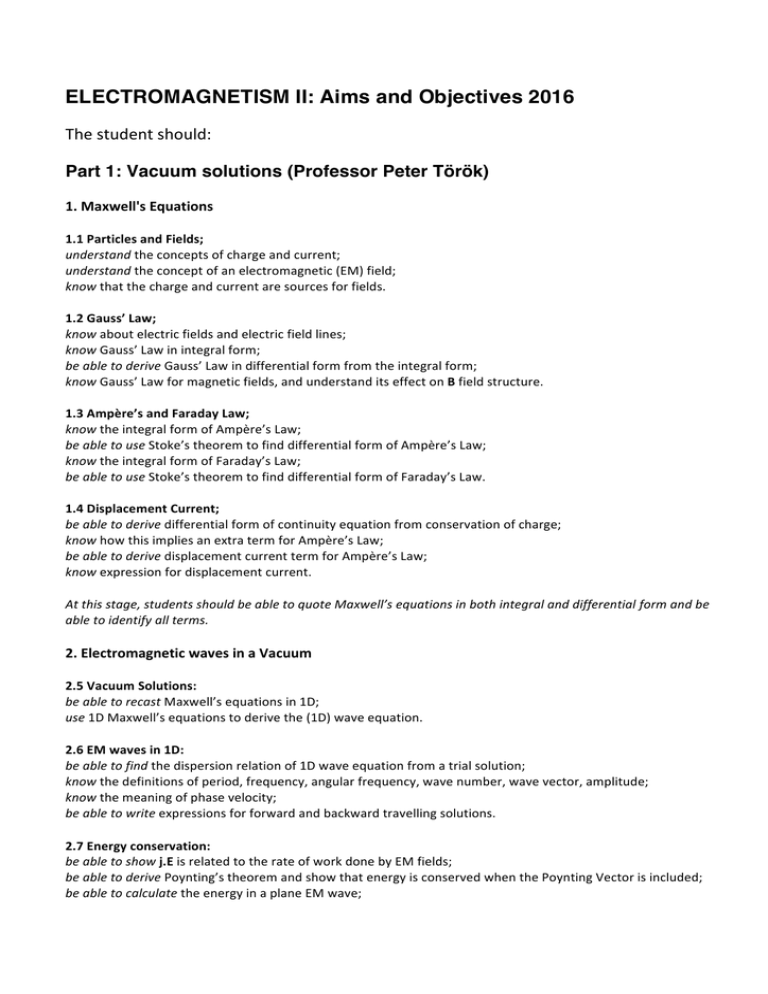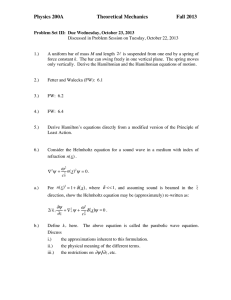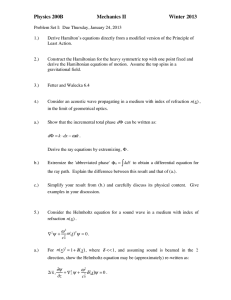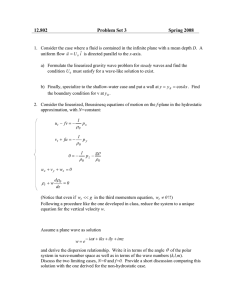ELECTROMAGNETISM II: Aims and Objectives 2016
advertisement

ELECTROMAGNETISM II: Aims and Objectives 2016 Thestudentshould: Part 1: Vacuum solutions (Professor Peter Török) 1.Maxwell'sEquations 1.1ParticlesandFields; understandtheconceptsofchargeandcurrent; understandtheconceptofanelectromagnetic(EM)field; knowthatthechargeandcurrentaresourcesforfields. 1.2Gauss’Law; knowaboutelectricfieldsandelectricfieldlines; knowGauss’Lawinintegralform; beabletoderiveGauss’Lawindifferentialformfromtheintegralform; knowGauss’Lawformagneticfields,andunderstanditseffectonBfieldstructure. 1.3Ampère’sandFaradayLaw; knowtheintegralformofAmpère’sLaw; beabletouseStoke’stheoremtofinddifferentialformofAmpère’sLaw; knowtheintegralformofFaraday’sLaw; beabletouseStoke’stheoremtofinddifferentialformofFaraday’sLaw. 1.4DisplacementCurrent; beabletoderivedifferentialformofcontinuityequationfromconservationofcharge; knowhowthisimpliesanextratermforAmpère’sLaw; beabletoderivedisplacementcurrenttermforAmpère’sLaw; knowexpressionfordisplacementcurrent. Atthisstage,studentsshouldbeabletoquoteMaxwell’sequationsinbothintegralanddifferentialformandbe abletoidentifyallterms. 2.ElectromagneticwavesinaVacuum 2.5VacuumSolutions: beabletorecastMaxwell’sequationsin1D; use1DMaxwell’sequationstoderivethe(1D)waveequation. 2.6EMwavesin1D: beabletofindthedispersionrelationof1Dwaveequationfromatrialsolution; knowthedefinitionsofperiod,frequency,angularfrequency,wavenumber,wavevector,amplitude; knowthemeaningofphasevelocity; beabletowriteexpressionsforforwardandbackwardtravellingsolutions. 2.7Energyconservation: beabletoshowj.EisrelatedtotherateofworkdonebyEMfields; beabletoderivePoynting’stheoremandshowthatenergyisconservedwhenthePoyntingVectorisincluded; beabletocalculatetheenergyinaplaneEMwave; knowthemeaningofpolarisation; beabletodemonstratethatPoyntingvectorN=c.(energydensity); beabletocalculateaveragerateofenergyflow,andusethistocalculatetheEfieldforEMwavesofgiven intensity. 3.Potentials 3.8Electrostaticpotential: knowtheconceptofelectrostaticpotentialandwhyitisuseful; beabletoderivePoisson’sequationfromthedefinitionofV; knowtheexpressionofVforapointsource; knowhowtousethistofindpotentialforextendedsourcesorcollectionsofcharges. 3.9VectorPotentials: knowthedefinitionofvectorpotential,A; knowthelimitationsofdefiningavectorpotentialandtheuseofgauges. 3.10Potential,chargeandcurrent: beabletowriteBandEintermsofVandA; beabletorewriteMaxwell’sequationsintermsofpotentialsintheLorenzgauge; knowthatwithoutsources,equationsforpotentialsreverttowaveequations. 3.11Solvingforpotentials,retardedpotentials: knowthatthesourceequationscanbesolvedbysplittingintoindividualpointsources,bysuperposition; showthatsolutiontosourceequationsforapointsourceisasphericalwaveemanatingfromorigin; knowthesignificanceofretardedtime. 3.12Solvingfortime-harmonicproblems: beabletoderivethetimeharmonicwaveequationforB,E,VandAwithandwithoutsources; beabletoderivethesolutionforAandVbysuperposition beabletoderivesolutionsofBandEforsimplegeometries. Part 2: EM fields and materials (Dr Michael Coppins) knowaboutpolarisationchargesandmagnetisationcurrentsandtheirmicroscopicorigin; knowtherelationshipbetweenEandD,andBandH; understandthetermsrelativepermittivityandpermeability,andelectricandmagnetic susceptibility; understandthetermsparamagnetic,diamagnetic,andferromagnetic; beabletorewriteMaxwell’sequationswithmaterialeffectsincluded; understandtheDrudemodelofconductionandbeabletouseittoestimatetheresistivityofa conductor; knowOhm’slawintermsofEandj; understandtheskineffect,andbeabletoderiveanexpressionfortheskindepth; beabletoderivethewaveequationanddispersionrelationinadielectric; knowthedefinitionofrefractiveindex; understandthetermdispersionappliedtoemwaves,andknowsituationsinwhichitoccurs; beabletoderivetheboundaryconditionsforthefieldsattheinterfacebetweentwoarbitrarymaterials; knowtheboundaryconditionsintheirmostgeneralformandhowtoapplythemtospecialcases; beabletocalculatethereflectionandtransmissioncoefficientsatnormalincidence; beabletoshowthatphasematchingleadstothelawsofreflectionandrefraction(Snell’slaw); beabletoderivetheFresnellawsforboths-andp-polarisations; knowthatreflectivityiszeroatBrewster’sAngleandbeabletocalculatethisangle; beabletoshowthatpropagationfromhightolowrefractiveindexcanleadtototalinternalreflection; beabletofindtheformofthetransmittedandreflectedfieldsinthecaseoftotalinternalreflection; understandevanescence; beabletoderive,andfindthesolutionsto,thewaveequationforconductors; beabletotakehighandlowfrequencylimitsforemwavepropagationinconductors; beabletoshowthatforpoorconductors(highfrequency)thesolutioncorrespondstoadampedwave propagation; beabletofindthesolutionsforbothEandBatthesurfaceofagoodconductor; beabletofindtherefractiveindexofametal; knowtheboundaryconditionsatametalsurface(forgoodandperfectconductors); beabletocalculatethereflectivityofaconductingsurface; understandradiationpressure; beabletoderivethewaveequationinaplasma; beabletofinddispersionrelationinaplasma; beabletoderivephaseandgroupvelocityinaplasma; beabletoshowthatdispersionrelationleadstoacut-off:i.e.alowerlimittofrequency.




